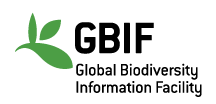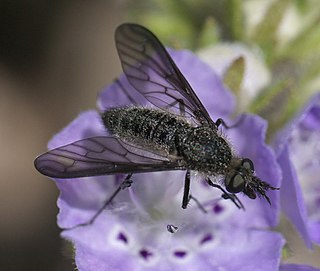
Marmots are large ground squirrels in the genus Marmota, with 15 species living in Asia, Europe, and North America. These herbivores are active during the summer, when they can often be found in groups, but are not seen during the winter, when they hibernate underground. They are the heaviest members of the squirrel family.

Triprion is a genus of frogs in the family Hylidae found in the Pacific lowlands of Mexico, the Yucatán Peninsula, and Guatemala. These frogs hide in tree-holes and plug the entrance with their strange-looking, bony heads.

The Global Biodiversity Information Facility (GBIF) is an international organisation that focuses on making scientific data on biodiversity available via the Internet using web services. The data are provided by many institutions from around the world; GBIF's information architecture makes these data accessible and searchable through a single portal. Data available through the GBIF portal are primarily distribution data on plants, animals, fungi, and microbes for the world, and scientific names data.

Palaemonidae is a family of shrimp in the order Decapoda. Many species are carnivores that eat small invertebrates, and can be found in any aquatic habitat except the deep sea. One significant genus is Macrobrachium, which contains commercially fished species. Others inhabit coral reefs, where they associate with certain invertebrates, such as sponges, cnidarians, mollusks, and echinoderms, as cleaner shrimps, parasites, or commensals. They generally feed on detritus, though some are carnivores and hunt tiny animals.
The Catalogue of Life is an online database that provides an index of known species of animals, plants, fungi, and microorganisms. It was created in 2001 as a partnership between the global Species 2000 and the American Integrated Taxonomic Information System. The Catalogue is used by research scientists, citizen scientists, educators, and policy makers. The Catalogue is also used by the Biodiversity Heritage Library, the Barcode of Life Data System, Encyclopedia of Life, and the Global Biodiversity Information Facility. The Catalogue currently compiles data from 165 peer-reviewed taxonomic databases that are maintained by specialist institutions around the world. As of September 2022, the COL Checklist lists 2,067,951 of the world's 2.2m extant species known to taxonomists on the planet at present time.

Campiglossa is a genus of fruit flies in the family Tephritidae. There are at least 190 described species in Campiglossa.

The quince monitor is a species of monitor lizards endemic to Indonesia. It is very closely related to the mangrove monitor, with both belonging to the subgenus Euprepiosaurus.
iNaturalist is a social network of naturalists, citizen scientists, and biologists built on the concept of mapping and sharing observations of biodiversity across the globe. iNaturalist may be accessed via its website or from its mobile applications. As of 21 September 2022, iNaturalist users had contributed approximately 115,651,000 observations of plants, animals, fungi, and other organisms worldwide, and around 245,700 users were active in the previous 30 days.
Vittore Benedetto Antonio Trevisan de Saint-Léon was an Italian botanist who specialized in cryptogamic flora.

Richard Lawrence Pyle, Ph.D. is a scuba diver and ichthyologist working on Hawaii.

Conophorini is a tribe of bee flies in the family Bombyliidae. There are about 11 genera and 125 described species in Conophorini.

Chloropinae is a subfamily of grass flies in the family Chloropidae.

Thelia is a genus of treehoppers in the family Membracidae. There are at least two described species in Thelia.

Thaumastocoridae is a family of true bugs in the order Hemiptera. There are about 9 genera and more than 20 described species in the family Thaumastocoridae.

Microminae is a subfamily of neuropteran insects of the family Hemerobiidae.

The Interim Register of Marine and Nonmarine Genera (IRMNG) is a taxonomic database which attempts to cover published genus names for all domains of life from 1758 in zoology up to the present, arranged in a single, internally consistent taxonomic hierarchy, for the benefit of Biodiversity Informatics initiatives plus general users of biodiversity (taxonomic) information. In addition to containing over 490,000 published genus name instances as at March 2020, the database holds over 1.7 million species names, although this component of the data is not maintained in as current or complete state as the genus-level holdings. IRMNG can be queried online for access to the latest version of the dataset and is also made available as periodic snapshots or data dumps for import/upload into other systems as desired.
Myrabolia is the only genus in the beetle family Myraboliidae in the superfamily Cucujoidea. It has about 13 species, found in Australia. Adults and possibly larvae live under the bark of Eucalyptus trees.
Finlaysonia is a genus of flowering plants in the dogbane family Apocynaceae, found from Sri Lanka, India, through Southeast Asia, New Guinea, northern Australia, the Philippines, and Palau. They tend to be vines or climbers and prefer to live on limestone, alongside rivers, or in mangrove swamps.
Cyperus elatus is a species of Cyperus in the sedge family, Cyperaceae, which is found from China to tropical Asia, and to Indonesia.
Basiliolidae is a family of brachiopods belonging to the order Rhynchonellida.













